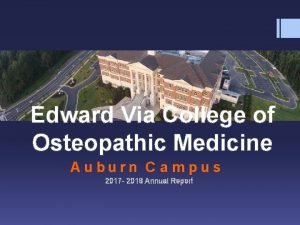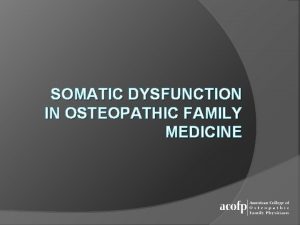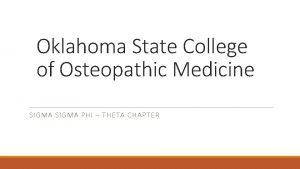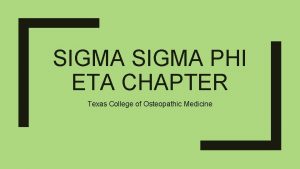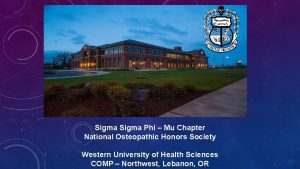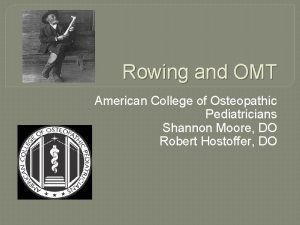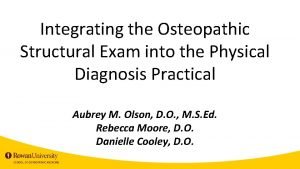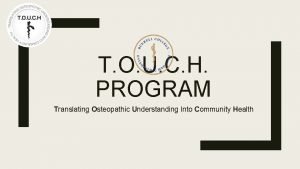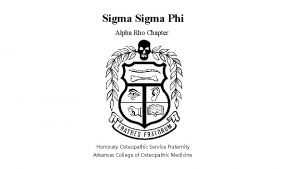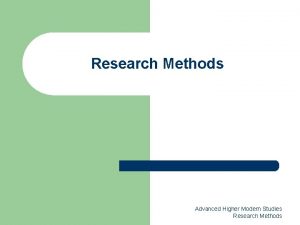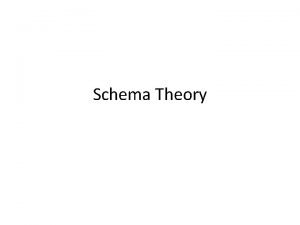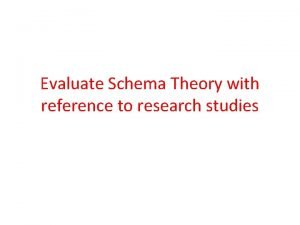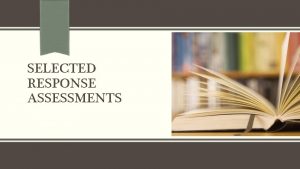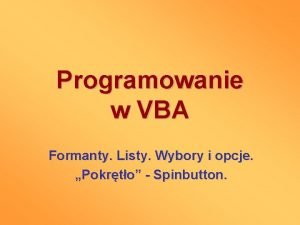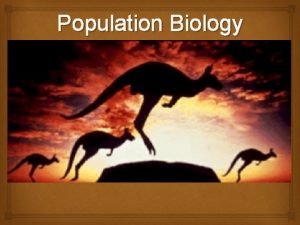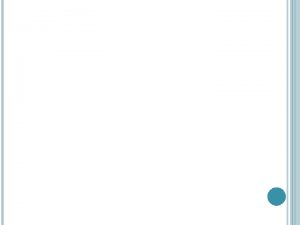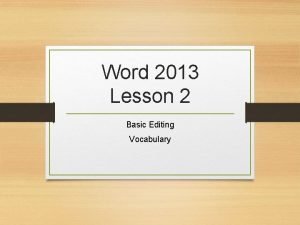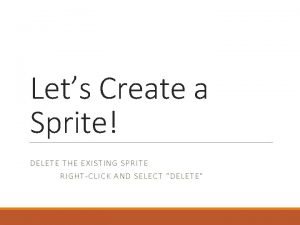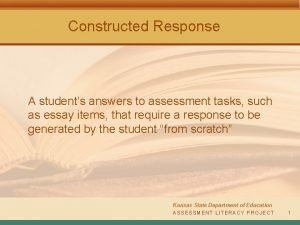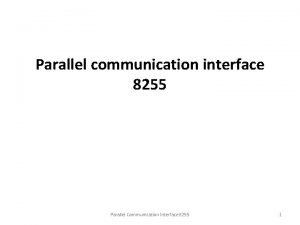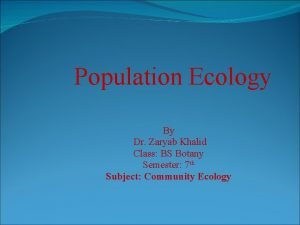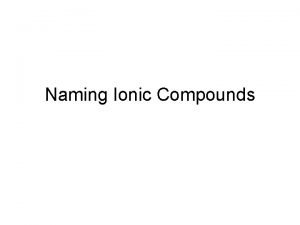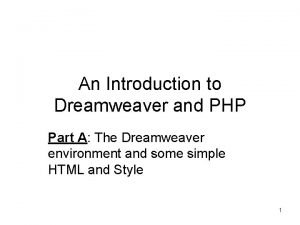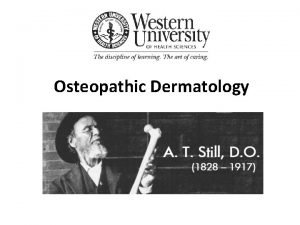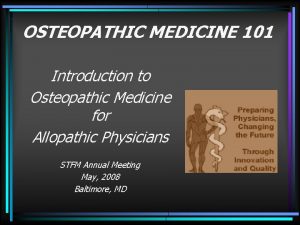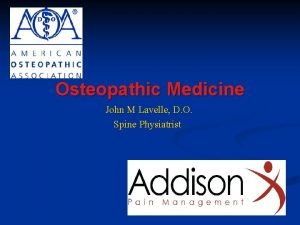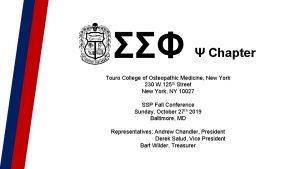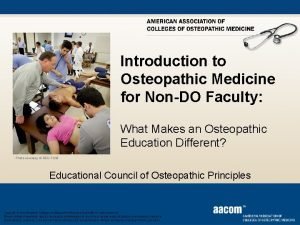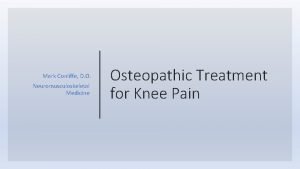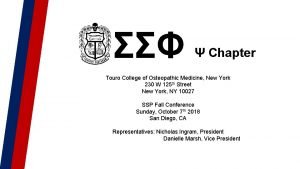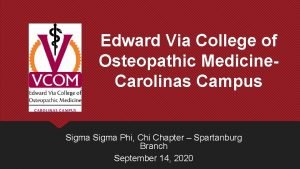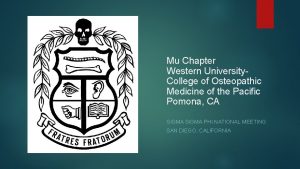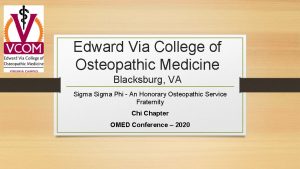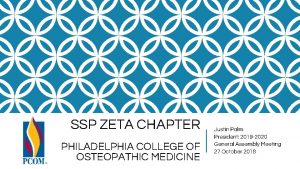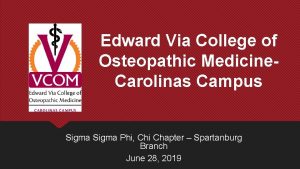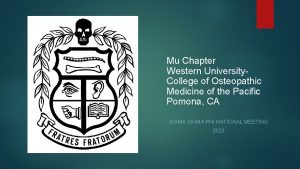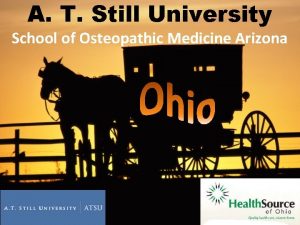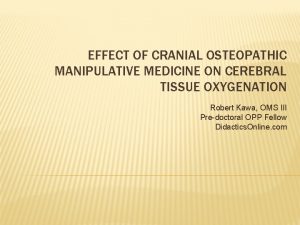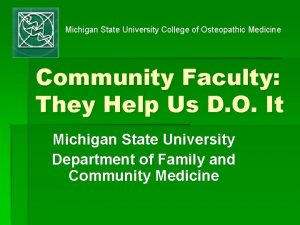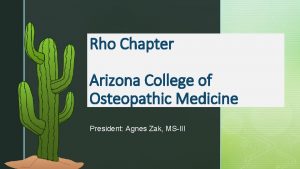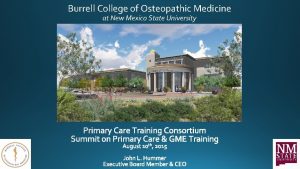SELECTED OSTEOPATHIC MEDICINE RESEARCH STUDIES David P Yens




































- Slides: 36

SELECTED OSTEOPATHIC MEDICINE RESEARCH STUDIES David P. Yens, Ph. D. Associate Professor New York College of Osteopathic Medicine


WHY? “Otitis media is the most common bacterial infection among children, accounting for as many as 30 million office visits annually. Proper treatment has become critical as offending pathogens become increasingly resistant to antibiotics and the cost of managing the disorder has exceeded 3 billion dollars per year. ” (Darrow, et. al. , 2003)


ACUTE OTITIS MEDIA OBJECTIVE Study effects of osteopathic manipulative treatment as an adjuvant therapy to routine pediatric care in children with recurrent acute otitis media.

DESIGN PLANNING COMPARISON OF PROTOCOLS/ RESEARCH -- OTITIS MEDIA D. Yens, NYCOM Category DescriptionResearch Group Mills; Tulsa Steele, WVa Worden, Tucson Degenhardt & Kuchera Carreiro NECOM (pilot – completed) Design characteristics Prospective X X X Blinded X X Control groups 1 1 1 X Two-way analysis, OMT & Herbal therapy X

SELECTION OF DEPENDENT VARIABLES n Tympanogram: Peak pressure Peak sharp or gradual n n n Presence of asymptomatic middle-ear effusions Frequency of infections Symptoms # antibiotic use # OM-related antibiotic treatment days Need for surgery/tube placement / Surg referrals Office visits Referral to ENT for recurrent OM after entry into the study Elimination of middle ear effusion for period of 6 months (persistence) Time to resolution of effusion Time to first recurrence of acute infection & effusion Duration of effusion when it recurred Mills X X X

SELECTION OF OTHER VARIABLES Mills n OMM vs Drug only (OMM is adjunctive) X n OMT, herbal treatment CONTROL VARIABLES Historical factors X

TIME AND SUBJECTS n DURATION OF STUDY 6 Months n AGE RANGE 6 months - 6 years n NUMBER OF GROUPS 2 n (Another study: 4 groups, each with exp & control group, depending upon type of OM) EFFECT SIZE/POWER Sample size analysis/Power analysis Power. 85 -. 80 Power analysis & risk reduction NUMBER OF SUBJECTS n Expect 20% attrition 50 per group

OMM TECHNIQUES USED Ø Ø Ø Balanced membranous tension Balanced ligimentous tension Myofascial release Muscle energy Facilitated positional release Strain-counterstrain

OTHER METHODS Ø Initial audiological evaluation Ø 9 visits for both groups, Ø 3 weekly Ø 3 biweekly Ø 3 monthly Ø Hx at each visit Ø Tympanograms obtained monthly

SUBJECTS n 146 patients referred Enrolled Dropouts Analyzed Intervention 31 6 (19%) 25 Controls 45 13 (29%) 32 Total 76 19 57

SIGNIFICANT RESULTS n Monthly episodes of AOM: n Intervention group < control, p=. 04 n Intervention group improvement in AOM episodes: n Intervention group > control, p=. 02 n Surgical interventions (tube inserts): n Intervention < control, p=. 03 n # months surgery free: n Intervention > control, p=. 01 n Sum of audiologists’ tympanogram readings: n Intervention better than control, p=. 02 n Parents’ satisfaction: n Intervention > control, p=. 02

LIMITATIONS n Dropout rate higher than expected n Intervention group somewhat sicker at baseline than control group n Length of study (3 months might be adequate) n Ideal # treatments still to be determined n NO PLACEBO CONTROL GROUP n Parents knew treatment group (consent) n Behavior rating scales not normalized or validated

CONCLUSIONS/ RECOMMENDATIONS Children who met eligibility criteria for this study also meet AHRQ (Agency for Healthcare Research and Quality) guidelines for consideration of surgical intervention if they also had compromised hearing. OMT may provide benefits during this window of risk for surgery. OMT appears to offer potential benefit as adjuvant therapy for children with recurrent AOM.

CRITIQUE (from editorial) n Accuracy of otoscopic diagnosis n Imbalance in groups: intervention group older, sicker, higher prescription rate; potential regression to mean validity problem n Control group dropouts possibly due to perception of no benefit (problem of informed consent) n LACK OF PLACEBO CONTROL GROUP n Effective reassurance and close follow-up might be just as effective

FUTURE PLANS n Osteopathic Research Center study planned with Karen Steele, D. O, as PI To be designed by a committee of experts as a larger multicenter trial. n Funding for the meeting to be provided by the Roebuck fund on recommendation of the Louisa Burns Osteopathic Research Committee of the American Academy of Osteopathy n NIH funding to be sought for the study n

LESSONS FOR CLINICAL OSTEOPATHIC RESEARCH n Use of a placebo n Need for a large N n Specific OMT protocol vs. treat what you find


n JAOA Vol 103 • No 9 • September 2003 • 417 -421 n Osteopathic Manipulative Treatment in the Emergency Department for Patients With Acute Ankle Injuries n Anita W. Eisenhart, DO n Theodore J. Gaeta, DO, MPH n David P. Yens, Ph. D n St. Barnabas Hospital, Bronx, NY

OBJECTIVE n Study Objective: The purpose of this study was to evaluate n the efficacy of osteopathic manipulative treatment (OMT) n as administered in the emergency department (ED) for n the treatment of patients with acute ankle injuries.

METHODS n Patients aged 18 years and older with unilateral ankle sprains were randomly assigned either to an OMT study group or a control group. n Independent outcome variables included edema, n range of motion (ROM) n pain n Both groups received the current standard of care for ankle sprains and were instructed to return for a followup examination. n Patients in the OMT study group also received one session of OMT from an osteopathic physician. n

OSTEOPATHIC METHOD n The fibula and tibia should be palpated. n There is often a slight torsion of the interosseous ligament with the proximal fibula noted to be more posterior. This effect can be reduced using simple torsion and soft tissue techniques. n Using soft tissue and fascial techniques, the osteopathic physician can evaluate and then treat the patient by examining the relationships of the bones from the toes to the ankle. n For example, given the common laxity of the fibularis muscles, there is often a dropped cuboideum (cuboid bone), which has to be reduced.

OSTEOPATHIC METHOD - 2 n A patient who has pain and tenderness along the fibularis muscles and tendons can be treated by using muscle energy and strain and counterstrain techniques. n Additionally, strain and counterstrain techniques will often help if used directly on the anterior talofibular ligament, especially in cases of first-degree sprains. n Lymphatic drainage techniques should be used to reduce pain from edema.

RESULTS n Patients in the OMT study group had a statistically significant (F = 5. 92, P =. 02) improvement in edema and pain and a trend toward increased ROM immediately following intervention with OMT. n Although at follow-up both study groups demonstrated significant improvement, patients in the OMT study group had a statistically significant improvement in ROM when compared with patients in the control group.



Conclusions n Data clearly demonstrate that a single session of OMT in the ED can have a significant effect in the management of acute ankle injuries.


Increased Lymphatic Flow in the Thoracic Duct During Manipulative Intervention n E. Marty Knott, OMS V; Johnathan D. Tune, Ph. D; Scott T. Stoll, DO, Ph. D; H. Fred Downey, Ph. D n JAOA • Vol 105 • No 10 • October 2005 • 447 -456 n University of North Texas Health Science Center at Fort Worth—Texas College of Osteopathic Medicine

SUMMARY n The thoracic pump and the abdominal pump are osteopathic manipulative (OM) lymphatic pump techniques frequently used by osteopathic physicians to treat patients with infections (eg, pneumonia, otitis media). n Although there is a widely accepted belief among the osteopathic medical profession that increasing lymphatic flow is beneficial, no measurements of lymph flow during osteopathic manipulative treatment have been reported. n The authors surgically instrumented five mongrel dogs to record lymphatic flow in the thoracic duct (TDF) and cardiac variables during three intervention protocols.

METHODS n Canine subjects were placed in a standing- support sling, and TDF, cardiac output, mean aortic blood pressure, and heart rate were recorded during two randomized 30 -second sessions of manipulative intervention using the osteopathic thoracic pump and abdominal pump techniques on two successive days.



CONCLUSION n The authors conclude that physical activity and manipulative intervention using thoracic pump and abdominal pump techniques produced net increases in TDF (P<. 05).

 Vcom white coat ceremony
Vcom white coat ceremony Urt
Urt Oklahoma state college of osteopathic medicine
Oklahoma state college of osteopathic medicine Psi sigma alpha osteopathic honor society
Psi sigma alpha osteopathic honor society Psi sigma alpha osteopathic honor society
Psi sigma alpha osteopathic honor society Rib somatic dysfunction
Rib somatic dysfunction Omm in physical exam
Omm in physical exam Touch program osteopathic
Touch program osteopathic Arcom mission statement
Arcom mission statement Paradigm shift from women studies to gender studies
Paradigm shift from women studies to gender studies Gender schema theory evaluation
Gender schema theory evaluation Advanced higher modern studies research methods
Advanced higher modern studies research methods Market segmentation definition gcse
Market segmentation definition gcse Example of a schema
Example of a schema Evaluation schema
Evaluation schema Words images objects qualitative or quantitative
Words images objects qualitative or quantitative Survivorship curve for k selected species
Survivorship curve for k selected species Selected response questions
Selected response questions Role of quantitative research
Role of quantitative research Vba listbox selected item value
Vba listbox selected item value K selected species survivorship curve
K selected species survivorship curve Example of r selected species
Example of r selected species Ounces of ice cream in a large milkshake
Ounces of ice cream in a large milkshake Word basic
Word basic Ann arbor mi population pyramid
Ann arbor mi population pyramid Not only the students but also their instructor
Not only the students but also their instructor How can you add a new costume of sprite
How can you add a new costume of sprite Selected response tasks
Selected response tasks The bsr and the io modes of 8255 is selected by the
The bsr and the io modes of 8255 is selected by the Congratulations you have been selected
Congratulations you have been selected Three randomly selected households are surveyed 2 6 7
Three randomly selected households are surveyed 2 6 7 K selected
K selected R-selected species
R-selected species Ionic compounds
Ionic compounds Whats conditional relative frequency
Whats conditional relative frequency Gwen harwood selected poems
Gwen harwood selected poems Web authoring using adobe dreamweaver - selected response
Web authoring using adobe dreamweaver - selected response
